Contents
Report 5 of the 8 February 2007 meeting of the Professional Standards & Complaints Committee and this report includes data for the 12 months to December 2006. It focuses on the key changes or exceptions within the data, as trends are slow to change.
Warning: This is archived material and may be out of date. The Metropolitan Police Authority has been replaced by the Mayor's Office for Policing and Crime (MOPC).
See the MOPC website for further information.
Complaints management information
Report: 5
Date: 8 February 2006
By: AC Directorate of Professional Standards on behalf of the Commissioner
Summary
This report includes data for the 12 months to December 2006. It focuses on the key changes or exceptions within the data, as trends are slow to change.
Workload
There has been an increase of 24% in the number of public complaint allegations being recorded over the past 12 months from a monthly average of 516 to 682.
The number of conduct matter allegations recorded over the same period shows only minor variation and the monthly average is now 92 per month.
Timeliness
The average number of days to complete a public complaint investigation remains below the threshold of 90-days but it has risen slightly from 70 days in January 2006 to 81 in December 2006.
The average number of days to complete an investigation into a conduct matter continues to improve and it also remains below the threshold of 90-days. It reduced by 2%, from a peak of 85 days in January 2006 to 83 in December 2006.
The average number of days between the decision to hold a misconduct hearing or final disposal is additionally below the threshold of 100 days and, at 78 days in December 2006, the lowest since it became a performance indicator.
A. Recommendations
That members note the report and the illustration of trends in the report and the Borough performance information contained in Appendices 1 and 2.
B. Supporting information
1. Appendix 1 contains data relating to Borough or Operational Command Unit performance.
2. Appendix 2 contains diversity information in respect of the Borough or Operational Command Units.
Allegations Recorded
Figure 1: Allegations Recorded: Public Complaints and Conduct Matters – Monthly Average
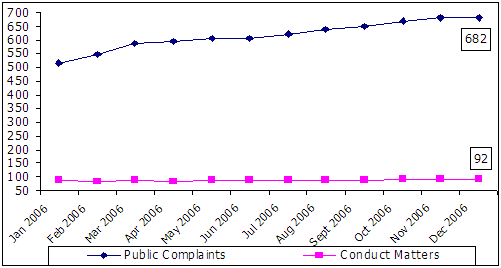
3. There has been an increase of 24% in the number of public complaint allegations being recorded over the past 12 months from a monthly average of 516 to 682.
4. Over the 12 months to December 2006, the average number of conduct matter allegations recorded each month has stabilised at 92.
5. The overall average increase in public complaints in the 12-months to December 2006 is not proportionate across all allegation categories. Using the actual 12-month rolling average figures over an extended period, it was possible to see that there was a distinct upward trend for certain types. The most significant trend appears with rises in Failures in Duty, Malpractice, Discriminatory Behaviour and Incivility.
6. This rise in Discriminatory Behaviour can be traced back to the introduction of the IPCC when there was a widening of the definition of such allegations to include Religion, Gender and Sexuality etc. This category also incorporates the new type of allegations made about ‘Fairness and Impartiality’ brought in by the Commission in April 2004. Although there has been a numerical rise in these types of allegations, as a proportion, they have reduced from 7% of the total in 2004/05 to 6% at the end of 2005/06. For 2006/07, to the end of December, this allegation type is 6% of the total.
7. Failure in Duty allegations continue to rise steadily. At the end of 2005/06 such allegations had risen by over 1000 and represented 38% of all allegations recorded against 27% in both 2003/04 and 2004/05. The rise has continued into 2006/07 with 38% of all allegations being in this category at the end of December 2006. Since the inception of the IPCC, DPS are investigating a higher proportion of failure in duty allegations that have come via the Commission. It is possible that, before the IPCC, some of these issues may not have been brought to the attention of DPS.
8. Incivility allegations have also risen in numerical terms since the inception of the IPCC in April 2004 but have reduced as a proportion of all allegations from 22% of the total in 2003/04 to 17% in 2005/06. At the end of December 2006, they represented 17% of all allegations.
9. Oppressive Behaviour allegations that had previously risen significantly due to the ‘Pro-Hunt’ demonstrations now appear to be on the decline as a proportion of the overall total. In 2004/05 they represented 38%, which reduced to 30% in 2005/06. This has carried through to 2006/07 when, at the end of December 2006, they were 29% of the total.
10. The following table illustrates the number of public complaints recorded over the period January 2006 to December 2006. It is also broken down by type, calculated per 100 officers and the period split into 3-month periods.
Figure 2: The number of public complaints recorded over the period January 2006 to December 2006.
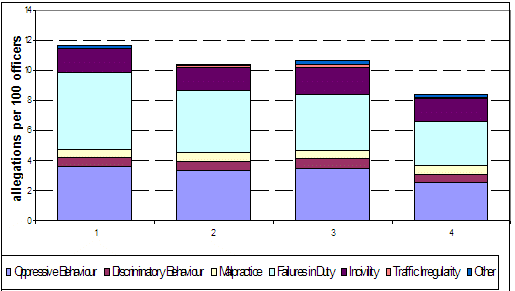
11. The table below illustrates the numbers of allegations by type and whether a period is above the MPS period average in which case the figures will be in bold text. The MPS total number of allegations, per 100 officers, over the 12-month period is also shown for comparison.
| Period 1: Mar-06 to Jan-06 |
Period 2: Jun-06 to Apr-06 |
Period 3: Sep-06 to Jul-06 |
Period 4: Dec-06 to Oct-06 |
Period averages | MPS total | |
|---|---|---|---|---|---|---|
| Oppressive Behaviour | 3.60 | 3.36 | 3.47 | 2.57 | 3.41 | 13.00 |
| Discriminatory Behaviour | 0.62 | 0.57 | 0.68 | 0.55 | 0.59 | 2.41 |
| Malpractice | 0.57 | 0.58 | 0.58 | 0.57 | 0.57 | 2.30 |
| Failures in Duty | 5.08 | 4.16 | 3.63 | 2.96 | 3.89 | 15.82 |
| Incivility | 1.57 | 1.59 | 1.92 | 1.50 | 1.58 | 6.58 |
| Traffic Irregularity | 0.05 | 0.04 | 0.08 | 0.07 | 0.06 | 0.23 |
| Other | 0.17 | 0.11 | 0.36 | 0.18 | 0.17 | 0.82 |
| Total | 11.66 | 10.41 | 10.71 | 8.39 | 10.56 | 41.16 |
12. Period 1 and 2, January 2006 to June 2006, shows the rise in Failure in Duty allegations resulting from the Danish Newspaper Cartoon protests recorded during this period. Other allegations types above the period averages are too small to be significant.
Timeliness - Public Complaints
Figure 3: Average days taken to complete full investigation & all other results
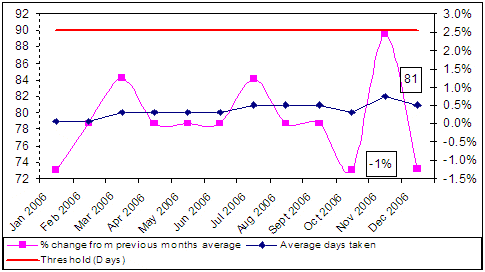
Meeting target: Investigating complaints within the 90-day threshold (81 days)
13. The average number of days to complete a public complaint remains at 81 days and has remained at a similar level since December 2005.
14. Since January 2006, the average number of days taken to complete an investigation has increased by 2 days (8%) from 79 days to 81 in December 2006 although this remains within the threshold of 90 days.
Meeting target: A month on month reduction in the average number of days to complete an investigation (1% decrease on the previous month)
15. There was a reduction of 1% in the average number of days taken to complete an investigation.
16. Presently, the potential to improve significantly further in this area is unlikely, as the current level has been achieved through changes to business processes and practices. However, the work being undertaken by DPS in respect of the changes to legislation brought about by the Taylor Review will afford another opportunity to review these practices. Current information suggests that the legislation will not now receive Royal Assent until Spring 2008.
Figure 4: Average Days Taken to Submit Dispensation/Discontinuance Requests to the IPCC
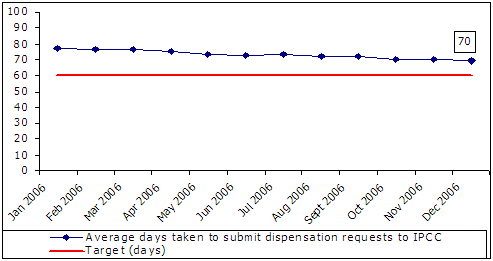
Missing target: Submitting requests for Dispensations /Discontinuances to the IPCC within a 60 day target (70 days)
17. Since January 2006, the average number of days taken to submit a dispensation or discontinuance request to the IPCC has reduced by 11% from 79 days to 70 days. However, although the trend is positive, this still remains above the 60-day target.
Figure 5: Average Days Taken to achieve a Local Resolution
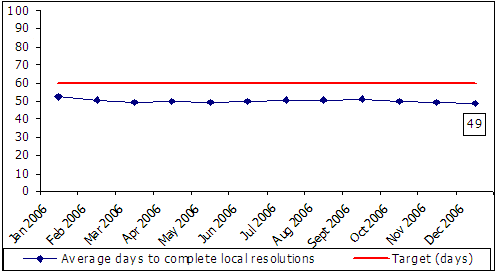
Meeting target: Average days taken to achieve a Local Resolution within a 60 day Target (49 days)
18. Since January 2006, the average number of days taken to achieve a local resolution has reduced by 6% from 52 days to 49 days. This is currently within the 60-day target.
19. Analysis of local resolutions reveals that, in the 12-months to December 2006, 58% have been achieved by DPS staff and the remaining 42% by Boroughs themselves. The proportion of local resolutions undertaken by DPS has increased, when compared to the previous 12 months, where it was previously 47%.
20. The decision for DPS staff to undertake as many local resolutions as possible was made at the Investigations Command SMT to ensure that timeliness remained under control.
Figure 6: Percentage of cases over 120-days* old – Public Complaints / Conduct Matters
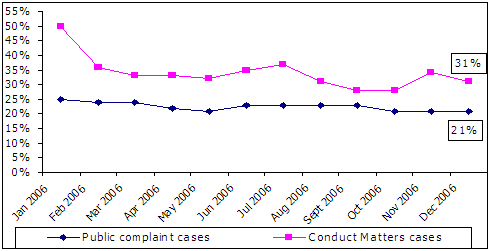
Meeting expectation: A reduction in the percentage of public complaint cases over 120-days* old
21. Following the impact of the significant incidents in July 2005 and the subsequent increase in the percentage of public complaint cases over 120 days [1] old, DPS continue to reduce this from a peak of 27% in October 2005 (179 of 667 cases) to 21% (204 of 980 cases) in December 2006. Although the trend remains downwards, there is still some way to go to achieve pre-July 2005 levels of between 14% and 17%.
22. The percentage of Conduct Matter cases is due to a number of Anti-Corruption Team investigations that have become ‘overt’ and recorded on the complaints system but happen to be over 120-days old.
Conduct Matters
Figure 7: Average days taken to complete an investigation
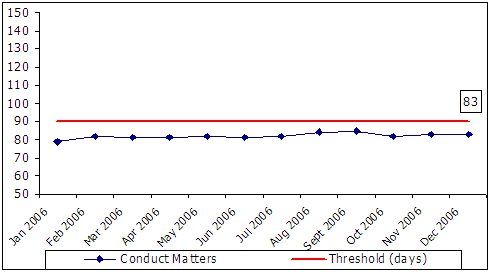
Meeting target: The average number of days to complete an investigation (83 against a 90 threshold)
23. The average number of days to complete a conduct matter investigation, illustrated on the previous page, remains below the threshold of 90-days. It reduced by 2%, from a peak of 85 days in September 2006 to 83 in December 2006.
Meeting expectation: A reduction in the percentage of conduct matter cases over 120 days [1] old
24. Following the significant impact of the incidents in July 2005, Conduct Matters over 120 days old rose from 36% (48 of 133 cases) in June to a peak of 60% (64 of 107 cases) in November 2005. However, since then, the trend is downward and now at 31% of the total (48 of 153 cases) in December 2006 following a rise to 34% in November 2006.
Misconduct
Figure 8: Misconduct – Average number of days from decision to hearing or final disposal
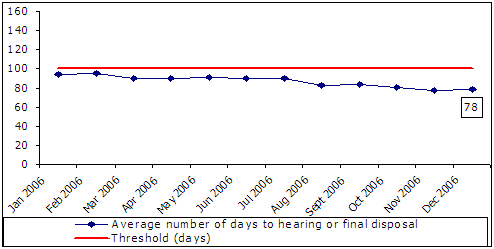
Meeting target: Average days to reach Misconduct decisions (78 against 100 threshold)
25. The average number of days between the decision to hold a misconduct hearing or reach a final disposal remains below the revised threshold of 100-days and at 78 days is the lowest since the performance indicator was introduced.
External Partners – CPS Decision making
Figure 9: Average number of days from report to receipt of decision from CPS
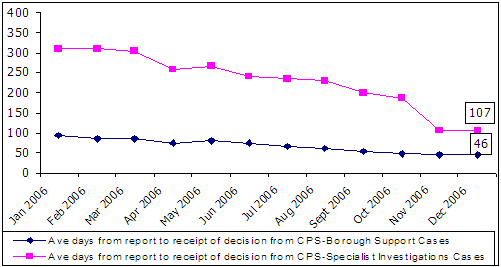
26. The chart above, illustrates the timeliness of the CPS decision-making in respect of the Specialist Investigation work, such as Deaths Following Police Contact and Discharge of Police Firearms and the more routine complaint and conduct investigations of the Borough Support Units.
External Partners – IPCC Decision making
Figure 10: Average number of days from report submission to receipt of decision from IPCC
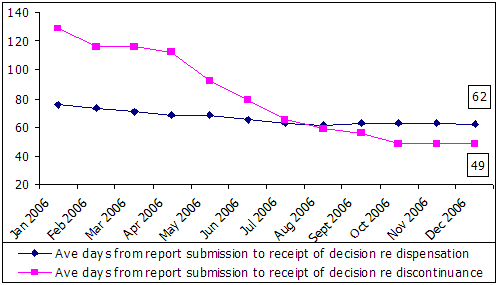
27. The chart above reveals the average time taken for the IPCC to reach decisions in dispensation and discontinuance cases.
Figure 11: Number of appeals made to the IPCC by type and outcome
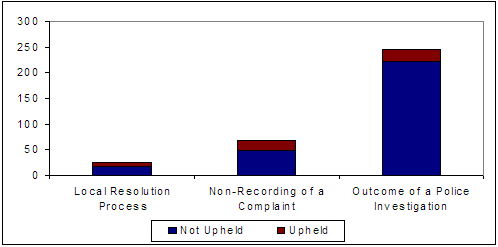
28. The chart above shows the number of appeals made to the IPCC where a decision has been received from the Commission within the last 12 months. It illustrates the type of appeal being made and the validity of that appeal as determined by the IPCC.
29. In future reports we intend to supply data for the current 12 months compared with the previous 12 months. To achieve this we need to ‘back record convert’ the data we hold manually to the new TRIBUNE fields. It is planned to conduct a further reconciliation exercise with the IPCC following the upgrade of TRIBUNE scheduled for spring 2007.
Outcome Trends
Figure 12: Public Complaints Finalised allegation by result
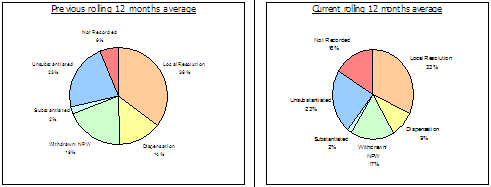
30. The average percentage of local resolutions has reduced in the 12-month period from 36% in December 2005 to 33% in December 2006 and remains considerably below the target of 50%. Whilst the proportions of the other outcomes affect this figure, it is likely to remain low until BOCUs are able to take on more responsibility for the resolution of their own complaints and undertake lower level investigations.
31. There are however tensions between the desire to see more issues being dealt with locally e.g. Local Resolutions and the scrutiny DPS is under to improve timeliness. DPS investigators losing close control over a complaint being investigated/resolved on borough can adversely impact on their timeliness and the inclination is for them to recall the file and deal with it themselves.
32. The increase in the proportion of allegations shown as not recorded as public complaints, under the Police Reform Act, in the current 12-month is due to the finalisation of 809 allegations arising out of the Danish Newspaper Cartoon protests.
Borough (BOCU)/Operational Command Unit (OCU) Performance – Public Complaints: Allegations and People
33. At each Professional Standards and Complaints Committee, members will be presented with a comparative analysis of public complaint data relating to groups of BOCUs in relation to MPS professional standards matters.
34. The BOCU groupings are made using the Territorial Policing Performance Focus Meeting (TP PFM) cluster.
35. The exception to this is what DPS have called Group 6, which consists of TP non-Borough based units and non-TP Operational Command Units.
36. The TP families have been grouped together based on demographics and volume crime within the boroughs in question. Both of these factors are likely to affect complaints. By using these family groups and converting actual numbers of complaints recorded into a ‘per 100 officers’ figure enables more accurate comparisons to be made.
37. This information provides a benchmark against which the Authority will be able to judge DPS’s Professional Standards Support Programme (PSSP) in the future by looking for variations in performance from this report to the next occasion the same family group appears.
38. Variations in performance of each of the boroughs when compared to their peers are highlighted in bold text. Variations could be for any number of reasons such as a particular operation/initiative being run on the borough or environmental factors such as the number of licensed premises, entertainment venues or shopping centres. The demographics in relation to both the resident and transient population and the length of service and experience of the officers concerned will also be relevant factors.
39. It should be noted that, once the ‘per 100 officers’ element is introduced to the data, some of the numbers are small which makes it difficult to draw any significant conclusions from them.
40. Because a Borough or Command Unit is different from their peers does not automatically mean that they are worse.
41. The Professional Standards Support Program (PSSP) incorporates a ‘tasking’ process whereby information in relation to public complaints, conduct matters, civil actions, accident claims and intelligence are assessed in order to ascertain what intervention activities are most appropriate to assist the boroughs with. The borough requiring the most assistance will have a ‘profile’ compiled on it based on all the information previously mentioned but in greater detail by drilling down into the data to establish the exact nature and likely cause of the variation.
42. The Prevention & Organisational Learning Command (POL) will then work with the borough in question, through the PSSP process, to define an action plan that will bring the BOCU closer to the average of similar boroughs in their group.
43. The group of boroughs under focus for this period are from Group 2. The data and associated analysis is presented in Appendix 1.
Tribune
44. Tribune is the ‘new’ computer system that was introduced into DPS in May 2006 following a development phase involving many of the users themselves. It is used to record information in relation to public complaints, conduct matters and any associated misconduct procedures. It is from this system that the data for this report is taken.
45. The Tribune system was an improvement on its predecessor by allowing the following:
- Flagging of ‘multiple’ factors in relation to any allegations. For example alcohol, CS spray and Handcuffs. This allows a greater depth of analysis to be undertaken.
- Production of electronically generated letters to complainants and officers/staff informing them of the progress of their complaint
- Electronic transfer of data, bi-annually, to the IPCC, which lessens the work in producing accurate/balanced end-of-year figures.
- Improved data accuracy by incorporating a number of mandatory fields, free-text fields replaced by standardised lookup lists and significantly an in-built finalisation check that will indicate to a user that a number of key fields have not been completed and not allow the case to be finalised without them being done.
- On the basis of these data quality enhancements, the Performance Analysis Unit have introduced ‘weekly’ audit checks of data that is fed back to the users and reviewed for compliance.
- A pictorial representation of the relationship between the complainant, the allegations they are making and against whom. This enables users to more easily link up the various elements.
- Being a Windows based application it allows for cut and paste of information between other MS applications such as Outlook e-mails, Word or Excel. This reduces the amount of keying that a user might otherwise be required to undertake.
- The MPA Professional Standards Officer now has access to Tribune to assist the Authority with their oversight role and in particular the Case Management Protocol and the review of completed cases.
46. We are currently working on phase 3 enhancements to Tribune and implementation is currently scheduled for the end of March 2007. This is, of course, subject to satisfactory factory & site testing. The proposed improvements include the following: -
- A weekly feed of MetHR personal data for police staff. (This currently occurs only for police officers with police staff details being added manually).
- The MetHR feed will include organisational information down to team level, which will enhance the analytical capability in seeing any possible ‘clustering’ of like-minded individuals.
- The introduction of further mandatory fields
- Improved finalisation checks that will verify against other items e.g. that court or misconduct records involving ‘proven’ or ‘guilty’ results have an associated sanction.
- The introduction of a new screen to record details of an arrest/caution of any police officer or member of staff.
- Anticipation of the system requirements necessary due to the Taylor Report recommendations such as whether a case is Misconduct or Gross Misconduct.
- Introduction of all six strands of diversity for complainants and officers/staff i.e. Ethnicity, Gender, Age, Disability, Faith/Religion and Sexual Orientation. Currently only Ethnicity, Gender & Age is recorded).
- Reports inbuilt that are used to monitor performance such as Investigating Officer Workload Analysis (IOWA) and Investigating Officer Throughput Analysis (IOTA) inbuilt
- ‘Whiteboard’ progress warnings that will highlight both forthcoming and overdue activities
- Increasing the number of licences and thus the number of concurrent users able to access the system
- Improved IPCC appeal data by allowing the ‘Not Valid’ appeals result. This will better ensure that data produced by the MPS and the IPCC bears a resemblance to each other.
C. Race and equality impact
Appendix 2 includes MPS data in respect of diversity relating to both complainants and officers that is compared against the family of Boroughs or Operational Command Units in focus.
D. Financial implications
The actual costs for implementing TRIBUNE in 2005/06 were approximately £58,000 (Phase 1) and £197, 000 (Phase 2). The changes required as part of Phase 3, due for implementation in late 2006/07, are estimated to be approximately £125,000.
E. Background papers
None.
F. Contact details
Report author(s): Michael Clark, Higher Performance Analyst and Andrew Campbell, Temporary Detective Chief Superintendent
For more information contact:
MPA general: 020 7202 0202
Media enquiries: 020 7202 0217/18
Appendix 1: Group 2
Figure A1: Public Complaints allegations per 100 officers by type – January 2006 to December 2006
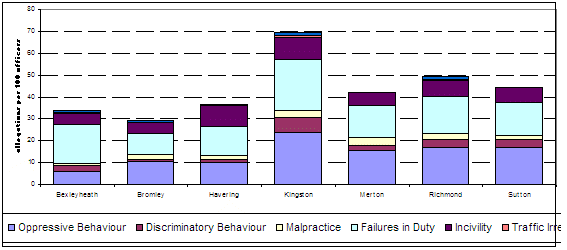
In line with wider MPS public complaint distribution, the majority of allegations are concentrated in the areas of oppressive behaviour, failures in duty and incivility.
The following table illustrates the numbers of allegations, per 100 officers, by type and whether a borough is above the group average, in which case the figures will be in bold text. The TP and MPS averages are also illustrated for comparison.
| TP PFM Family Group 2 | Bexleyheath | Bromley | Havering | Kingston | Merton | Richmond | Sutton |
|---|---|---|---|---|---|---|---|
| Oppressive Behaviour | 6.10 | 10.44 | 10.01 | 23.58 | 15.51 | 16.73 | 17.13 |
| Discriminatory Behaviour | 2.62 | 1.00 | 1.54 | 6.89 | 2.18 | 3.75 | 3.56 |
| Malpractice | 0.87 | 2.21 | 1.54 | 3.27 | 3.81 | 2.73 | 1.62 |
| Failures in Duty | 17.73 | 9.64 | 13.35 | 23.22 | 14.69 | 17.07 | 15.19 |
| Incivility | 5.23 | 5.02 | 9.75 | 10.16 | 5.71 | 7.17 | 6.79 |
| Traffic Irregularity | 0.58 | 0.20 | 0.00 | 1.09 | 0.00 | 0.68 | 0.00 |
| Other | 0.87 | 0.60 | 0.26 | 1.09 | 0.00 | 1.37 | 0.00 |
| Total | 34.01 | 29.11 | 36.44 | 69.30 | 41.89 | 49.50 | 44.28 |
| TP PFM Family Group 2 | Group averages | TP total | MPS total |
|---|---|---|---|
| Oppressive Behaviour | 15.51 | 16.76 | 13.00 |
| Discriminatory Behaviour | 2.62 | 2.98 | 2.41 |
| Malpractice | 2.21 | 2.82 | 2.30 |
| Failures in Duty | 15.19 | 22.46 | 15.82 |
| Incivility | 6.79 | 8.62 | 6.58 |
| Traffic Irregularity | 0.20 | 0.24 | 0.23 |
| Other | 0.60 | 0.97 | 0.82 |
| Total | 41.89 | 54.85 | 41.16 |
As a group TPFM have an average number of allegations per 100 officers that is lower than that of TP as a whole and similar to the overall MPS average. It can be seen that, within the group, there is a wide range of total allegations per 100 officers, between 69 (Kingston) and 29 (Bromley).
Figures for Kingston, Richmond and Sutton are all above the group average with Kingston and Richmond; this is evident across all allegation types. Kingston in particular has a total that is 27 allegations per 100 officers more than the average of its peers and 20 more than the next nearest borough, Richmond.
Kingston has a greater overall number of allegations per 100 officers an apparent higher proportion in relation to oppressive behaviour, discriminatory behaviour, failure in duty and incivility.
The following tables illustrate specific factors, per 100 officers, evident within the allegations recorded in the table at the bottom of page 13.
| TP PFM Family Group 2 | Bexleyheath | Bromley | Havering | Kingston | Merton | Richmond | Sutton |
|---|---|---|---|---|---|---|---|
| Officer Safety Equipment | 1.45 | 3.61 | 2.05 | 3.99 | 0.54 | 8.53 | 0.65 |
| Stop & Search (inc s44) | 1.45 | 0.40 | 0.77 | 4.72 | 3.26 | 1.02 | 3.88 |
| TP PFM Family Group 2 | Group averages | TP total | MPS total |
|---|---|---|---|
| Officer Safety Equipment | 2.05 | 3.27 | 2.43 |
| Stop & Search (inc s44) | 1.45 | 5.06 | 4.33 |
Richmond has over four times the group average of allegations per 100 officers in respect of Officer Safety Equipment. (OSE will include the allegations related to the use of Handcuffs, Batons, and CS Spray etc). Kingston, have over twice the group average number of allegations in which Officer Safety Equipment (OSE) is a factor but which is more similar, to the TP average.
Kingston, Merton and Sutton all have at least double the group average Stop & Search related allegations but are all below the TP totals.
The following tables illustrate the monthly average trends, per 100 officers, for each group over the last month, 3 months, 6 months and 12 months.
| TP PFM Family Group 2 | Bexleyheath | Bromley | Havering | Kingston | Merton | Richmond | Sutton |
|---|---|---|---|---|---|---|---|
| Current month (actual) | 1.45 | 1.81 | 0.00 | 1.81 | 1.90 | 1.71 | 3.88 |
| Average over the past 3 months | 1.65 | 2.48 | 1.37 | 7.38 | 2.45 | 3.30 | 3.66 |
| Average over the past 6 months | 1.70 | 2.11 | 1.50 | 6.29 | 2.54 | 5.06 | 3.45 |
| Average over the past 12 months | 2.83 | 2.43 | 3.04 | 5.78 | 3.49 | 4.12 | 3.69 |
| TP PFM Family Group 2 | Group averages | TP total | MPS total |
|---|---|---|---|
| Current month (actual) | 1.81 | 2.80 | 2.18 |
| Average over the past 3 months | 2.48 | 3.74 | 2.80 |
| Average over the past 6 months | 2.54 | 4.24 | 3.18 |
| Average over the past 12 months | 3.49 | 4.57 | 3.43 |
Kingston appears above the group trend over the past 12 months. Long-term trends also support this and reveal a consistent increase in complaints per 100 officers within Kingston, above that experienced by its peers, since Summer 2005.
A similar situation exists within Richmond too whereby long-term trends indicate a consistent rise but one which does not yet take them significantly above the group average.
Outcomes (Allegations):
The following tables illustrate how allegations, per 100 officers, have been resulted in the period, January 2006 to December 2006.
| TP PFM Family Group 2 | Bexleyheath | Bromley | Havering | Kingston | Merton | Richmond | Sutton |
|---|---|---|---|---|---|---|---|
| Not Recorded | 1.45 | 4.22 | 2.57 | 1.45 | 1.09 | 1.02 | 0.97 |
| Local Resolution | 17.73 | 10.64 | 18.48 | 30.12 | 8.16 | 19.80 | 10.67 |
| Dispensation | 2.91 | 1.41 | 2.57 | 5.44 | 0.82 | 3.41 | 1.62 |
| Discontinuance | 0.00 | 0.00 | 0.00 | 0.36 | 0.00 | 0.00 | 0.00 |
| Withdrawn | 10.75 | 8.23 | 6.93 | 15.24 | 8.43 | 9.90 | 8.73 |
| Substantiated | 0.00 | 1.61 | 0.00 | 0.36 | 0.54 | 0.34 | 0.32 |
| Unsubstantiated | 5.52 | 19.27 | 5.65 | 9.80 | 13.60 | 14.34 | 20.36 |
| Grand Total | 38.37 | 45.38 | 36.19 | 62.77 | 32.65 | 48.81 | 42.67 |
| TP PFM Family Group 2 | Group averages | TP total | MPS total |
|---|---|---|---|
| Not Recorded | 1.45 | 6.83 | 4.60 |
| Local Resolution | 17.73 | 16.87 | 12.73 |
| Dispensation | 2.57 | 4.80 | 3.49 |
| Discontinuance | 0.00 | 0.41 | 0.37 |
| Withdrawn | 8.73 | 10.19 | 7.37 |
| Substantiated | 0.34 | 0.73 | 0.54 |
| Unsubstantiated | 13.60 | 15.78 | 12.51 |
| Grand Total | 42.67 | 55.60 | 41.61 |
As a group, group 2, Locally Resolve a slightly greater number of allegations per 100 officers than TP as a whole. Havering, Kingston and Richmond resolved a higher than MPS average number of allegations, which can be seen as encouraging.
Not Recorded allegations are those that are not deemed to be complaints under the Police Reform Act 2002, as they do not directly relate to the ‘conduct’ of an individual or group of officers. Although they are not recorded as complaints, they will nevertheless be recorded and dealt with to the satisfaction of the complainant by intervention between DPS and the Borough itself.
Dispensations are usually granted where the complainant cannot be traced or does not wish to cooperate with the investigation. The Commission is granting fewer Dispensations with their preference being for DPS to conduct proportionate investigations.
Appendix 2: Race and equality impact: Public Complaints allegations per 100 officers by type – January 2006 to December 2006: People
The next tables show the number of complainants within each borough over the last 12 months and breaks them down by ethnicity, gender and age. The MPS total is illustrated for comparison.
Number of complainants within each borough over the last 12 months
By ethnicity
| Complainant details |
TP PFM Family Group 2 | TP total | MPS total | ||||||
|---|---|---|---|---|---|---|---|---|---|
| Bexleyheath | Bromley | Havering | Kingston | Merton | Richmond | Sutton | |||
| White | 30 (56%) | 32 (45%) | 40 (62%) | 60 (50%) | 27 (35%) | 31 (38%) | 40 (57%) | 1240 (26%) | 1453 (26%) |
| Black | 6 (11%) | 11 (15%) | 3 (5%) | 12 (10%) | 23 (29%) | 7 (9%) | 8 (11%) | 859 (18%) | 1017 (18%) |
| Asian | 0 (0%) | 2 (3%) | 3 (5%) | 12 (10%) | 6 (8%) | 0 (0%) | 1 (1%) | 263 (5%) | 304 (5%) |
| Other | 0 (0%) | 1 (1%) | 0 (0%) | 0 (0%) | 1 (1%) | 1 (1%) | 0 (0%) | 44 (1%) | 58 (1%) |
| Unknown | 18 (33%) | 25 (35%) | 19 (29%) | 37(31%) | 21 (27%) | 43 (52%) | 21 (30%) | 2417 (50%) | 2839 (50%) |
| Total | 54 | 71 | 65 | 121 | 78 | 82 | 70 | 4823 | 5671 |
By gender
| Complainant details |
TP PFM Family Group 2 | TP total | MPS total | ||||||
|---|---|---|---|---|---|---|---|---|---|
| Bexleyheath | Bromley | Havering | Kingston | Merton | Richmond | Sutton | |||
| Female | 12 (22%) | 32 (45%) | 31 (48%) | 46 (38%) | 28 (36%) | 24 (29%) | 18 (26%) | 1505 (31%) | 1738 (31%) |
| Male | 42 (78%) | 39 (55%) | 33 (51%) | 73 (60%) | 50 (64%) | 58 (71%) | 52 (74%) | 3027 (63%) | 3624 (64%) |
| Unknown | 0 (0%) | 0 (0%) | 1 (2%) | 2 (2%) | 0 (0%) | 0 (0%) | 0 (0%) | 291 (6%) | 309 (5%) |
| Total | 54 | 71 | 65 | 121 | 78 | 82 | 70 | 4823 | 5671 |
By age
| Complainant details |
TP PFM Family Group 2 | TP total | MPS total | ||||||
|---|---|---|---|---|---|---|---|---|---|
| Bexleyheath | Bromley | Havering | Kingston | Merton | Richmond | Sutton | |||
| 0-16 years | 1 (2%) | 0 (0%) | 1 (2%) | 1 (1%) | 1 (1%) | 1 (1%) | 1 (1%) | 51 (1%) | 66 (1%) |
| 17-24 years | 6 (11%) | 8 (11%) | 8 (12%) | 23 (19%) | 7 (9%) | 5 (6%) | 7 (10%) | 436 (9%) | 519 (9%) |
| 25-44 years | 21 (39%) | 29 (41%) | 23 (35%) | 34 (28%) | 41 (53%) | 24 (29%) | 26 (37%) | 1447 (30%) | 1710 (30%) |
| 45-64 years | 8 (15%) | 9 (13%) | 11 (17%) | 17 (14%) | 11 (14%) | 13 (16%) | 13 (19%) | 586 (12%) | 698 (12%) |
| Over 65 years | 0 (0%) | 1 (1%) | 3 (5%) | 2 (2%) | 2 (3%) | 0 (0%) | 4 (6%) | 90 (2%) | 99 (2%) |
| Unknown | 18 (33%) | 24 (34%) | 19 (29%) | 44 (36%) | 16 (21%) | 39 (48%) | 19 (27%) | 2213 (46%) | 2579 (45%) |
| Total | 54 | 71 | 65 | 121 | 78 | 82 | 70 | 4823 | 5671 |
It can be seen that the ethnicity of the complainant is unknown in a high percentage of instances, on average 50% across the MPS. Within this group, the extent to which ethnicity is unknown ranges between 27% for Merton to 52% in Richmond.
DPS are implementing measures to improve data quality in this area. This issue will be brought to the attention of Borough Commanders and monitored through the PSSP process. Furthermore, DPS caseworkers have been asked to ensure this forms part of their role and of the file checking process before the file is returned for filing and storage. A supplementary letter is being prepared that can be sent to complainants where this information has not been collected by the Borough or IPCC in the first instance.
Where the ethnicity is known, it is evident that, a higher proportion of complainants are from non-white communities, most notably from, Black people. This is particularly so for Merton where 29% of known complainants are Black despite the lowest percentage of unknown ethnicity. At the time of the 2001 Census, data indicated that approximately 9% of the resident population in Merton were Black people.
The capture of gender related information is much better than that for ethnicity with the majority of complaints being made by males. Generally, the split between the genders is approximately 30% female and 70% so it is interesting to note that in Havering and to a lesser extent Bromley the split is almost 50/50.
In respect of the complainants’ age, the percentage where age is unknown is only marginally better than that for ethnicity. The highest proportion of complainants are aged between 25-44 years old, which was the same as was evident in the previous reports covering the TP PFM families. Within this group, the highest proportions of complainants under 24 years old are those complaining about events in Kingston.
The following table shows the number of officers within each group receiving complaints over the last 12 months and breaks them down by ethnicity, gender and length of service.
Number of officers within each group receiving complaints over the last 12 months
By ethnicity
| Officer details: | TP PFM Family Group 2 | TP total | MPS total | ||||||
|---|---|---|---|---|---|---|---|---|---|
| Bexleyheath | Bromley | Havering | Kingston | Merton | Richmond | Sutton | |||
| White | 62 (75%) | 59 (60%) | 72 (73%) | 97 (61%) | 75 (66%) | 78 (68%) | 59 (57%) | 3897 (56%) | 4964 (60%) |
| Black | 0 (0%) | 3 (3%) | 1 (1%) | 3 (2%) | 3 (3%) | 1 (1%) | 1 (1%) | 135 (2%) | 162 (2%) |
| Asian | 0 (0%) | 3 (3%) | 3 (3%) | 8 (5%) | 3 (3%) | 5 (4%) | 3 (3%) | 184 (3%) | 204 (2%) |
| Other | 0 (0%) | 1 (1%) | 1 (1%) | 5 (3%) | 1 (1%) | 2 (2%) | 0 (0%) | 97 (1%) | 115 (1%) |
| Unknown | 21 (25%) | 32 (33%) | 22 (22%) | 45 (28%) | 31 (27%) | 29 (25%) | 40 (39%) | 2593 (38%) | 2823 (34%) |
| Total | 83 | 98 | 99 | 158 | 113 | 115 | 103 | 6906 | 8268 |
By gender
| Officer details | TP PFM Family Group 2 | TP total | MPS total | ||||||
|---|---|---|---|---|---|---|---|---|---|
| Bexleyheath | Bromley | Havering | Kingston | Merton | Richmond | Sutton | |||
| Female | 11 (13%) | 11 (11%) | 15 (15%) | 13 (8%) | 13 (12%) | 16 (14%) | 16 (16%) | 809 (12%) | 907 (11%) |
| Male | 53 (64%) | 57 (58%) | 62 (63%) | 103 (65%) | 70 (62%) | 71 (62%) | 48 (47%) | 3589 (52%) | 4647 (56%) |
| Unknown | 19 (23%) | 30 (31%) | 22 (22%) | 42 (27%) | 30 (27%) | 28 (24%) | 39 (38%) | 2508 (36%) | 2714 (33%) |
| Total | 83 | 98 | 99 | 158 | 113 | 115 | 103 | 6906 | 8268 |
By length of service
| Officer details | TP PFM Family Group 2 | TP total | MPS total | ||||||
|---|---|---|---|---|---|---|---|---|---|
| Bexleyheath | Bromley | Havering | Kingston | Merton | Richmond | Sutton | |||
| 0-2 years | 18 (22%) | 17 (17%) | 24 (24%) | 28 (18%) | 16 (14%) | 19 (17%) | 13 (13%) | 1084 (16%) | 1161 (14%) |
| 3 years | 5 (6%) | 7 (7%) | 12 (12%) | 19 (12%) | 8 (7%) | 15 (13%) | 13 (13%) | 775 (11%) | 859 (10%) |
| 4 years | 8 (10%) | 12 (12%) | 10 (10%) | 15 (9%) | 7 (6%) | 4 (3%) | 6 (6%) | 518 (8%) | 618 (7%) |
| 5-9 years | 7 (8%) | 7 (7%) | 10 (10%) | 8 (5%) | 12 (11%) | 14 (12%) | 8 (8%) | 744 (11%) | 1027 (12%) |
| 10-14 years | 6 (7%) | 5 (5%) | 6 (6%) | 19 (12%) | 12 (11%) | 9 (8%) | 7 (7%) | 373 (5%) | 538 (7%) |
| 15-19 years | 9 (11%) | 10 (10%) | 4 (4%) | 7 (4%) | 8 (7%) | 12 (10%) | 4 (4%) | 315 (5%) | 475 (6%) |
| 20-24 years | 6 (7%) | 5 (5%) | 5 (5%) | 8 (5%) | 7 (6%) | 3 (3%) | 2 (2%) | 205 (3%) | 334 (4%) |
| 25-29 years | 2 (2%) | 3 (3%) | 3 (3%) | 6 (4%) | 9 (8%) | 6 (5%) | 4 (4%) | 152 (2%) | 243 (3%) |
| 30-34 years | 0 (0%) | 0 (0%) | 0 (0%) | 0 (0%) | 3 (3%) | 0 (0%) | 1 (1%) | 15 (0%) | 30 (0%) |
| 35-39 years | 0 (0%) | 0 (0%) | 0 (0%) | 0 (0%) | 0 (0%) | 0 (0%) | 0 (0%) | 3 (0%) | 3 (0%) |
| 40 years and over | 0 (0%) | 0 (0%) | 0 (0%) | 0 (0%) | 0 (0%) | 0 (0%) | 0 (0%) | 0 (0%) | 0 (0%) |
| Unknown | 22 (27%) | 32 (33%) | 25 (25%) | 48 (30%) | 31 (27%) | 33 (29%) | 45 (44%) | 2722 (39%) | 2980 (36%) |
| Total | 83 | 98 | 99 | 158 | 113 | 115 | 103 | 6906 | 8268 |
There is a high proportion where these details are not yet established – 29% on average across all indicators.
The numbers of non-white officers receiving complaints overall is small when compared with their white colleagues who make up the greater proportion of officer workforce. As a percentage, non-white officers appear to be complained of in a greater proportion to their representation within the MPS workforce would suggest. However, the recruitment policy in recent years has seen an increase in non-white officers whose length of service will mean they are more likely to be at constable/sergeant rank employed in front-line operation roles dealing with the public. Recent figures show that over half (55%) of the black & minority ethnic police officers have less than five years service compared to 30% overall.
Female officers currently represent approximately 20% of the overall police officer workforce and receive, on average, about 11% of the complaints. When put into context of the number of female officers based within BOCUs this figure is better as women represent 24% of the borough workforce.
The majority of officers who have contact with the public will be younger in service. An officer’s length of service may affect the numbers of complaints they receive. Early in their career probationer officers will be less experienced but likely to receive greater supervision. Once they complete the probation period, they will be supervised less but remain relatively inexperienced.
The following table illustrates the actual number of officers who have received formal sanctions or informal discipline in respect of allegations concluded in the 12 months to December 2006.
| TP PFM Family Group 2 | TP total | MPS total | |||||||
|---|---|---|---|---|---|---|---|---|---|
| Outcomes (Officers) | Bexleyheath | Bromley | Havering | Kingston | Merton | Richmond | Sutton | ||
| Criminal Prosecution | 0 | 0 | 0 | 0 | 1 | 0 | 0 | 1 | 2 |
| Misconduct Hearing | 0 | 0 | 0 | 0 | 0 | 0 | 0 | 11 | 18 |
| Written Warning | 0 | 1 | 0 | 0 | 0 | 0 | 1 | 20 | 28 |
| Informal Discipline | |||||||||
| Advice | 0 | 5 | 0 | 1 | 2 | 1 | 0 | 76 | 86 |
| Discussion | 0 | 0 | 0 | 0 | 0 | 0 | 0 | 1 | 1 |
| Guidance | 0 | 0 | 0 | 0 | 0 | 0 | 0 | 11 | 12 |
| Training | 0 | 0 | 0 | 0 | 1 | 0 | 0 | 2 | 2 |
Public Complaint allegations that are substantiated are usually within the region of 2 to 3% of all finalised allegations. It is therefore expected that there will be few formal outcomes such as a criminal prosecution or misconduct hearing.
A high number of written warnings may mean that it is being used as a means of dealing with minor misconduct issues rather than a higher number of officers whose conduct falls short of that expected and it should be seen as encouraging. A written warning means that the officer accepts the failing and is a key component in encouraging learning from past mistakes.
The table shows Advice being the most used form of informal discipline.
Professional Standards Support Program (PSSP)
By the time that this report appears at the MPA Professional Standards and Complaints Committee the PSSP tasking meeting will have taken place and a program of input tailored to each boroughs needs will have been defined. One borough in particular will have been identified as requiring additional support and a ‘profile’ will be prepared to facilitate this. The 'profile' will be based on all the data available but it will be analysed in greater detail, by drilling down into it, to establish the exact nature and potential causes of variation between that borough and its peers.
All of the group 2 Borough Commanders or their deputies (and their senior management teams) have been visited to raise the profile of DPS and advise them of what they can expect from the PSSP program. The meetings with the boroughs have been positive and they have been receptive to the aims of the support program. Briefings have been arranged with the Police Federation and Trade Union representatives and these will take place before the input starts on their particular borough.
Some of the initiatives that will be delivered to the boroughs, (through existing training cycles where possible), are as follows:
The core menu will be delivered to all BOCUs within the family group. This consists of a briefing to the Borough Commander to explain the purpose of PSSP and explore any Professional Standards issues arising. This has already taken place and has been a positive exercise in itself. The meetings have facilitated the exchange of good practice and encouraged useful suggestions for the future conduct of business between the boroughs and DPS.
Accident Claims are engaging with all BOCUs in the family group and are arranging to deliver their core messages and highlight good practice to borough practitioners. IBO managers, F&R managers and SMTs have all been identified as significant contacts for this area of work. Civil Actions talks are being tailored to individual borough needs. In Sutton, “off-duty” behaviour will be highlighted at the request of the OCU Commander. In Kingston, particular emphasis is already being placed on public order scenarios, an area of concern identified by the new Borough Commander.
The Computer Misuse package has been shown to several of BOCU commanders and has been well received. This will be a significant vehicle for the delivery of the wider Professional Standards message.
The "Core-Plus" programme will be delivered at the OCU identified as likely to benefit most from the additional support offered by PSSP. This will involve the delivery of the Custody (looking after prisoners) briefing, a review of officer safety complaints and training and a more detailed review of officers identified under the Complaints Intervention Scheme (officers with 3 or more public complaints or conduct matters recorded within a 12 month period).
There will also be additional input on Local Resolution awareness - rates and guidance on achieving them. Some BOCUs have already asked for some of the "Core-Plus" products to be delivered to a targeted audience and this will be delivered where resources allow. In the case of family 2, a degree of flexibility may be possible as most of the BOCUs are single site commands. A greater challenge will arise with Central London Boroughs forming family group 3. The tasking process with this group will be critical if the targeting of resources is to yield maximum benefit.
Footnotes
1. This indicator will be changed to 90-days in later reports but to do so requires a programming change to the source system. This is scheduled as part of the TRIBUNE Phase 3 upgrade to be completed by April 2007. [Back]
Send an e-mail linking to this page
Feedback